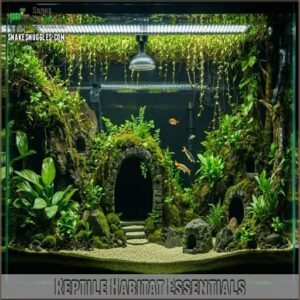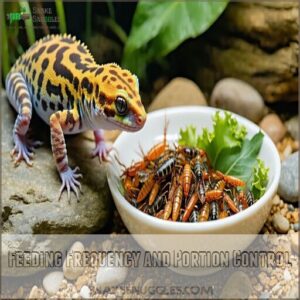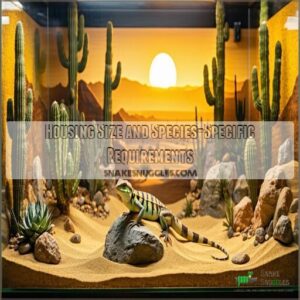This site is supported by our readers. We may earn a commission, at no cost to you, if you purchase through links.

You’ll need to create a cozy habitat with proper temperature zones and humidity levels, just like their natural home.
Think of it as building a five-star resort for your reptile! Provide a balanced diet with the right supplements, and keep their space squeaky clean to prevent illness.
Regular vet check-ups are your best defense against health issues. And here’s a little secret: each species has its own unique quirks and care requirements that can make all the difference in their well-being.
Table Of Contents
- Key Takeaways
- Reptile Habitat Essentials
- Dietary Needs and Nutrition
- Health and Hygiene Practices
- Environmental and Space Considerations
- Common Health Issues and Solutions
- Frequently Asked Questions (FAQs)
- How do you maintain a healthy living environment in a reptile enclosure?
- How do you know if a reptile is healthy?
- Do Reptiles need medical attention?
- How to care for a reptilian pet?
- How can we monitor reptile wellness naturally?
- What are the essentials for reptile care?
- Why is a not a reptile?
- What is the most important factor in reptile care?
- What 5 basic things are needed to house a reptile?
- How long do different reptile species typically live?
- Conclusion
Key Takeaways
- You’ll need to maintain precise temperature gradients (75-95°F) and humidity levels (40-60%) in your reptile’s habitat, along with proper UVB lighting and digital monitoring equipment to ensure accurate environmental control.
- You should establish a species-specific feeding schedule with the right balance of proteins, vitamins, and minerals, supplementing with calcium and vitamin D3 while providing clean, properly treated water.
- You must conduct regular health checks and schedule veterinary visits every 6-12 months, watching for signs like weight loss, lethargy, or incomplete shedding that could indicate health issues.
- You’ll want to create an appropriately sized enclosure with multiple hiding spots, climbing structures, and the right substrate that matches your reptile’s natural environment, allowing them to move and exercise freely.
Reptile Habitat Essentials
You’ll need to create a cozy home that meets your reptile’s specific needs for temperature, humidity, and lighting to keep them healthy and content.
Your scaly friend will thank you with better appetite and activity when you provide the right mix of hiding spots, proper substrate, and carefully selected furnishings that match their natural habitat, which includes providing a cozy home.
Temperature Gradients and Humidity
Anyone who’s kept reptiles knows that proper thermal regulation is the cornerstone of their health.
Your scaly friend needs precise temperature gradients and humidity control to thrive.
Here’s what to monitor in your reptile habitat setup:
- Maintain proper temperature fluctuations between 75-95°F
- Create basking zones with reliable heat sources
- Keep humidity levels between 40-60%
- Install digital thermometers and hygrometers for accurate moisture management
Accurate reptile thermometers are key for maintaining ideal temperatures.
Lighting and Substrate Selection
When setting up your reptile’s habitat, proper lighting and substrate selection play important roles in their health and happiness.
You’ll need to provide both UVB lighting and heat lamps to mimic natural conditions, with specific requirements varying by species.
| Lighting Type | Ideal Usage |
|---|---|
| UVB Bulbs | Daily 10-12 hours |
| Heat Lamps | Temperature gradient |
| Ceramic Heaters | Night warmth |
| LED Day Lights | Natural cycles |
| Mercury Vapor | All-in-one solution |
For substrate, choose materials that match your reptile’s natural environment, considering factors like humidity retention and digestive safety.
Hiding Spots and Furnishings
A well-furnished reptile habitat isn’t complete without strategic hiding spots.
Your scaly friend needs rock caves and hide boxes to feel secure and regulate their body temperature.
Add climbing structures for exercise, while plant decor creates a natural environment.
Water features also enhance the enclosure’s aesthetics but also help maintain proper humidity.
Remember to position these furnishings thoughtfully within your reptile’s environment.
Proper reptile habitat design requires considering reptile species requirements to make sure a healthy and thriving pet, with a focus on their specific species requirements and overall environment.
Dietary Needs and Nutrition
You’ll find that keeping your scaly friend healthy starts with understanding what and when to feed them, just like how you wouldn’t eat ice cream for every meal.
Your reptile’s diet needs to include the right balance of proteins, vitamins, and minerals, along with clean, properly treated water to keep them active and thriving, which is crucial for their overall health and well-being.
Feeding Frequency and Portion Control
Just like your unique habitat setup supports your reptile’s health, mastering their feeding schedule ensures they thrive.
Your scaly friend’s appetite varies based on species, age, and activity level.
Here’s your reptile nutrition guide:
- Young reptiles need more frequent meals than adults
- Ball pythons eat weekly as juveniles, every 7-10 days as adults
- Leopard geckos thrive on 1-2 weekly feedings
- Remove uneaten food after feeding sessions to maintain hygiene
Understanding reptile feeding schedules is essential for their overall health.
Balanced Diet and Supplement Requirements
A balanced diet serves as the foundation for your reptile’s overall health.
Your scaly friend needs nutrient balance through a variety of foods specific to their species. Most reptiles require calcium supplements and vitamin D3, especially when UVB lighting isn’t adequate.
Research your reptile’s dietary needs thoroughly—what works for bearded dragons won’t suit tortoises.
Proper reptile nutrition prevents metabolic bone disease and supports immune function. Providing adequate reptile nutrition is essential for maintaining their overall well-being.
Water Quality and Conditioners
Behind every healthy reptile is clean, safe water. Your scaly friend’s hydration needs depend on proper water quality for effective reptile health care.
- Test water regularly for chlorine and heavy metals
- Use reptile-specific conditioners like Reptisafe for chlorine removal
- Let tap water sit for 24 hours as an alternative to commercial conditioners
- Choose conditioners that add beneficial electrolytes for complete reptile hydration, which is essential for maintaining the health of your reptile, and ensuring they have access to proper water quality.
Health and Hygiene Practices
You’ll need to establish consistent health and hygiene practices to keep your scaly friend thriving for years to come.
Regular cleaning of your reptile’s habitat and careful attention to their physical condition will help prevent common diseases that can affect their quality of life, which is crucial for their well-being and quality of life.
Proper Handling and Safety Precautions
Now that you’ve fed your reptile friend properly, let’s talk handling.
Providing proper snake health and husbandry is paramount for their well-being.
Always wash your hands before and after handling your reptile, and support your snake’s body completely when lifting.
Use appropriate handling tools like hooks or gloves for certain species, and watch for stress signs—if your reptile seems agitated, return them to their enclosure immediately.
Confidence counts with handling techniques, but always prioritize your reptile’s safety , and remember to handle them with care and respect.
Regular Veterinary Check-Ups and Care
Through regular veterinary checkups, you’ll keep your scaly friend happy and healthy.
A complete veterinary care plan should include:
- Annual health screenings with diagnostic tests to catch issues early
- Emergency vet contact info readily available for medical emergencies
- Documentation of your reptile’s growth, weight, and behavior changes
- Scheduled checkups every 6-12 months with a specialized reptile veterinarian
This plan is crucial for maintaining your reptile’s overall health, and by following it, you can ensure your pet receives the best possible care and lives a long, healthy life.
Disease Prevention and Recognition
Now that you’ve established a relationship with your vet, you’ll want to stay ahead of potential health issues.
Watch for signs like weight loss, vomiting, or lethargy – these could signal bacterial diseases or viral infections.
Keep your reptile’s immune system strong through proper hygiene and parasite control.
Quick action and diagnostic tests can catch problems early, making treatment more effective and less stressful for your scaly friend, which is crucial for maintaining a strong immune system.
Environmental and Space Considerations
You’ll need to give your scaly friend enough space to move, bask, and explore just like they’d in nature.
Setting up the right environment isn’t just about size – it’s about creating a space that matches your reptile’s specific needs for temperature, lighting, and exercise.
Housing Size and Species-Specific Requirements
Considering housing size for reptiles is like choosing the right home for yourself – it must fit their unique needs.
Your reptile enclosure should accommodate your pet’s adult size, with plenty of room for natural behaviors. Different species require specific tank materials and habitat designs – desert dwellers need dry setups, while tropical reptiles thrive in humid environments.
Research species profiles before creating your reptile habitat to verify proper enclosure maintenance. When setting up a reptile habitat, it’s essential to account for the overall reptile enclosure needs to create a suitable environment, and you can find more information on reptile enclosure kits.
Space for Movement and Exercise
While reptiles may appear less active than other pets, they need adequate space to exercise their natural movement patterns.
Your reptile’s enclosure size should accommodate their activity levels and allow them to fully extend their bodies.
- Create climbing structures that mimic their natural environment
- Rearrange the habitat monthly to stimulate exploration and prevent boredom
- Monitor your reptile’s movement to verify their exercise needs are being met
Ethical Considerations for Reptile Ownership
Beyond movement space, your reptile’s wellbeing involves broader ethical questions.
You’re responsible for more than just a pet—you’re a steward of an exotic species.
When handling reptiles, especially snakes, it’s important to think about safe handling practices to make sure the well-being of both humans and animals.
| Ethical Aspect | Impact | Your Responsibility |
|---|---|---|
| Animal Rights | Physical/mental health | Provide complete reptile care |
| Conservation Impact | Wild population strain | Choose captive-bred animals |
| Welfare Standards | Quality of life | Exceed minimum requirements |
| Ethical Breeding | Genetic health | Support responsible breeders |
Consider how your choices affect reptile welfare and conservation before bringing home your scaly friend.
Common Health Issues and Solutions
You’ll face several common health challenges as you care for your reptile friend, from stuck sheds to mysterious appetite loss.
Knowing how to spot early warning signs and address these issues quickly can make the difference between a costly vet visit and a simple home remedy that gets your scaly buddy back to their basking, munching selves in no time, which can be a simple solution.
Shedding and Growth Issues
During the shedding process, your scaly friend will go through a delicate phase called ecdysis. Watch for signs like dull skin or behavioral changes that indicate molting is about to begin.
You’ll need to maintain proper humidity levels and provide rough surfaces for your pet to rub against.
If you notice incomplete shedding or skin issues, a warm soak can help loosen stubborn patches and promote scale health.
Loss of Appetite and Stress Signs
During times of stress, your scaly friend might suddenly lose interest in food.
Understanding these behavioral changes is important for maintaining reptile health. Snakes exhibit normal seasonal appetite fluctuations.
Watch for these key stress symptoms:
- Hiding more than usual or becoming unusually aggressive when approached
- Decreased activity levels and spending excessive time in cool areas
- Refusing food for multiple feeding cycles, especially if paired with weight loss
Contact your vet if these signs persist.
Recognizing and Addressing Illnesses and Injuries
While changes in appetite can signal trouble, keeping a watchful eye for physical symptoms is just as important.
Watch for these common reptile health issues and know when to seek help:
| Signs | Action | Urgency Level |
|---|---|---|
| Wheezing/bubbles | Check temperature, humidity | Immediate vet visit |
| Swollen joints | Assess diet, UV exposure | Within 24 hours |
| Open wounds | Clean, isolate pet | Emergency care |
Remember, early disease diagnosis and prompt wound care often lead to better outcomes for your scaly friend, and it is crucial to act with immediate vet visit for severe symptoms, and to provide emergency care when necessary.
Frequently Asked Questions (FAQs)
How do you maintain a healthy living environment in a reptile enclosure?
You’ll create an absolute paradise by maintaining proper temperature gradients, cleaning regularly, providing appropriate substrate, ensuring correct humidity levels, and checking water quality.
Don’t forget to add hiding spots for your reptile’s security.
How do you know if a reptile is healthy?
You’ll know your reptile is healthy when it has clear eyes, smooth skin/scales, regular eating habits, proper weight, and active behavior. Watch for normal breathing and waste elimination too.
Do Reptiles need medical attention?
Yes, reptiles need regular vet checkups just like other pets.
You’ll want to find an exotic animal specialist who can spot health issues before they become serious and provide preventative care.
How to care for a reptilian pet?
Like precious gems, reptiles require specialized care.
Provide proper habitat with temperature gradients, appropriate diet for your species, regular cleaning, access to fresh water.
Yearly vet checkups are essential to keep your scaly friend thriving.
How can we monitor reptile wellness naturally?
Watch your reptile’s behavior, activity levels, and eating habits daily.
You’ll spot health issues by examining clear eyes, smooth skin, regular bowel movements, and proper shedding—all signs of a thriving pet.
What are the essentials for reptile care?
You’d think reptiles just need a rock and some sun, but they’re much more complex.
Provide proper heating, UVB lighting, species-appropriate humidity, suitable enclosure size, correct substrate, and regular veterinary checkups.
These elements are crucial for the well-being of reptiles, and each plays a significant role in their health and survival.
Why is a not a reptile?
Frogs aren’t reptiles because they’re amphibians.
They also undergo metamorphosis from tadpoles to adults and don’t have amniotic eggs like reptiles do.
Unlike reptiles’ dry scales, frogs have moist, permeable skin.
What is the most important factor in reptile care?
Could you imagine tending to a delicate ecosystem in your home.
Temperature control is the most important factor in reptile care, as you’ll need proper gradients for digestion, immunity, and overall health.
What 5 basic things are needed to house a reptile?
You’ll need a proper enclosure, temperature gradient, appropriate substrate, hiding spots, and UVB lighting to house your reptile. These five essentials create a safe, stress-free environment for your scaly friend.
How long do different reptile species typically live?
Like marathon runners in the pet world, your reptiles will be with you for years.
You’ll find turtles living 30-50 years, snakes 15-30 years, and most lizards 10-30 years, with chameleons having shorter lifespans.
Conclusion
Just as a skilled gardener nurtures their plants, mastering reptile health care basics will help your scaly friend thrive.
You’ve now got the essential tools – from habitat setup to nutrition guidelines – to provide excellent care.
Remember, each species is unique, so tailor these tips to your pet’s specific needs.
With consistent attention to temperature, diet, and regular vet visits, you’ll create an environment where your reptile can flourish for years to come.
- https://www.birdandexoticsvet.com/reptile-health-identifying-and-preventing-common-issues/
- https://reptilesupershow.com/ultimate-guide-to-pet-reptile-care-essentials/
- https://www.merckvetmanual.com/exotic-and-laboratory-animals/reptiles/management-and-husbandry-of-reptiles
- https://www.lllreptile.com/library/2-care-and-husbandry-articles
- https://u.osu.edu/pets4life/pet-care-basics/reptiles/















